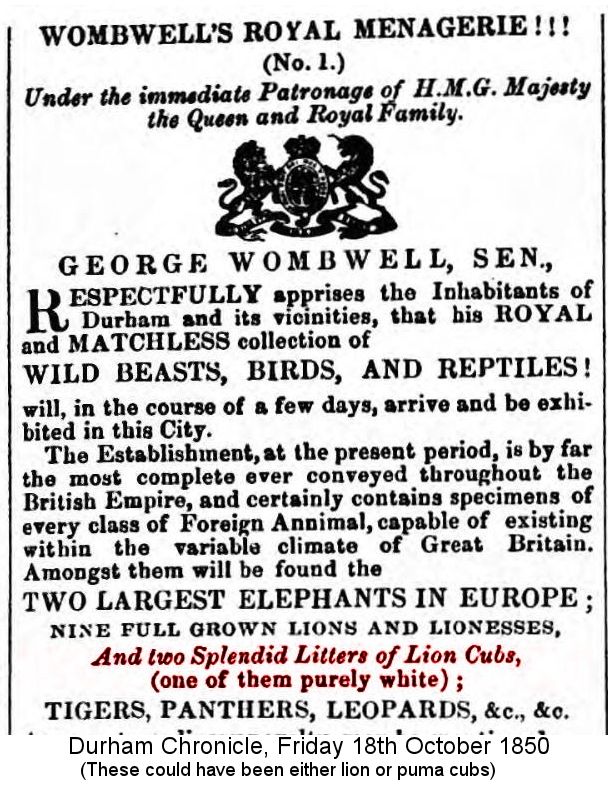
|
WHITE LIONS - MYTHOLOGY, HISTORY & GENETICS |
Mutants are natural variations that occur due to spontaneous genetic changes or the expression of recessive (hidden) genes through inbreeding. Common mutations in big cats are albinism (pure white), chinchilla (white with pale markings), leucism (partial albinism/cream) and melanism (black). White lions, also known as blond lions, are not albino, but are leucistic and are uncommon in the wild as they lack normal camouflage. In the past, the obvious reaction to any unusual big cat was to shoot it for the trophy room. Mutations may have been wiped out before the genes could be passed on. Colour mutations that would disadvantage a wild big cat are now perpetuated in captivity for the sake of curiosity or aesthetics.
I am grateful to Paul McCarthy and others for researching, providing and correcting extensive material, genealogies, historical and current information about white lions. Thanks are also due to Kevin Chambers of the Zoological Animal Reproduction Center for further information on white lions. More detailed information on the history and ecology of white lions may be found in Linda Tucker's book "Mystery of the White Lions - Children of the Sun God

White Lions 2: White Lions in Captivity Today
The White Lion in Mythology and Nature
Accounts of white lions have been around for centuries in Africa, but have often been dismissed as superstition. It has been part of African folklore since prehistoric times and according to legend white lions were children of the Sun God, sent to earth as gifts.
Oral traditions recalls the appearance of white lions over 400 years ago during the reign of Queen Numbi in the region now known as Timbavati. A shining star was seen to fall to the ground, but when Queen Numbi and her people approached, they found it to be a shining ball of metal, brighter than the sun. Queen Numbi, who was an elderly and infirm woman, was swallowed by its light and received by strange beings. When she emerged again, she had been restored to health and youth. The fallen star remained there for some days and then rose back into the sky. Animals with strange deformities were born in that region - cattle with 2 heads, white impala and green-eyed white leopards and lions. To this day, white animals are born in Timbavati, including a blue-eyed albino elephant that was shot by white hunters. Whether or not you believe in visiting spaceships, it is now known that radiation can cause mutations such as those described.

White lions were central to an April Fool's joke in 1860. Late in March of that year, numerous people throughout London received a plausible looking invitation saying "Tower of London - Admit Bearer and Friend to view annual ceremony of Washing the White Lions on Sunday, April 1, 1860. Admittance only at White Gate. It is particularly requested that no gratuities be given to wardens or attendants." By twelve noon on April 1, a large crowd had gathered outside the Tower of London in accordance with the invitation. Lions hadn't been kept in the tower for centuries; the Royal Menagerie having outgrown the tower and become the Royal Zoological Society's "Gardens" in Regent's Park). There were no captive white lions until late in the 20th century. On realising the joke, the disappointed crowd eventually dispersed.
An alternative explanation is that the recessive gene for white/blonde is part of the lion's genetic heritage from the days when lions roamed far more widely. Their habitats included snowy and desert regions where blonde and white colours give better camouflage than tawny and the more successful pale colour morph would come to predominate in such places.
While accounts of white lions have been around for centuries, they were dismissed as superstition. There are now around 300 white lions in captivity and they have been returned to the wild. However, like white tigers, they are an attractive man-perpetuated mutant strain rather than an endangered species in their own right.
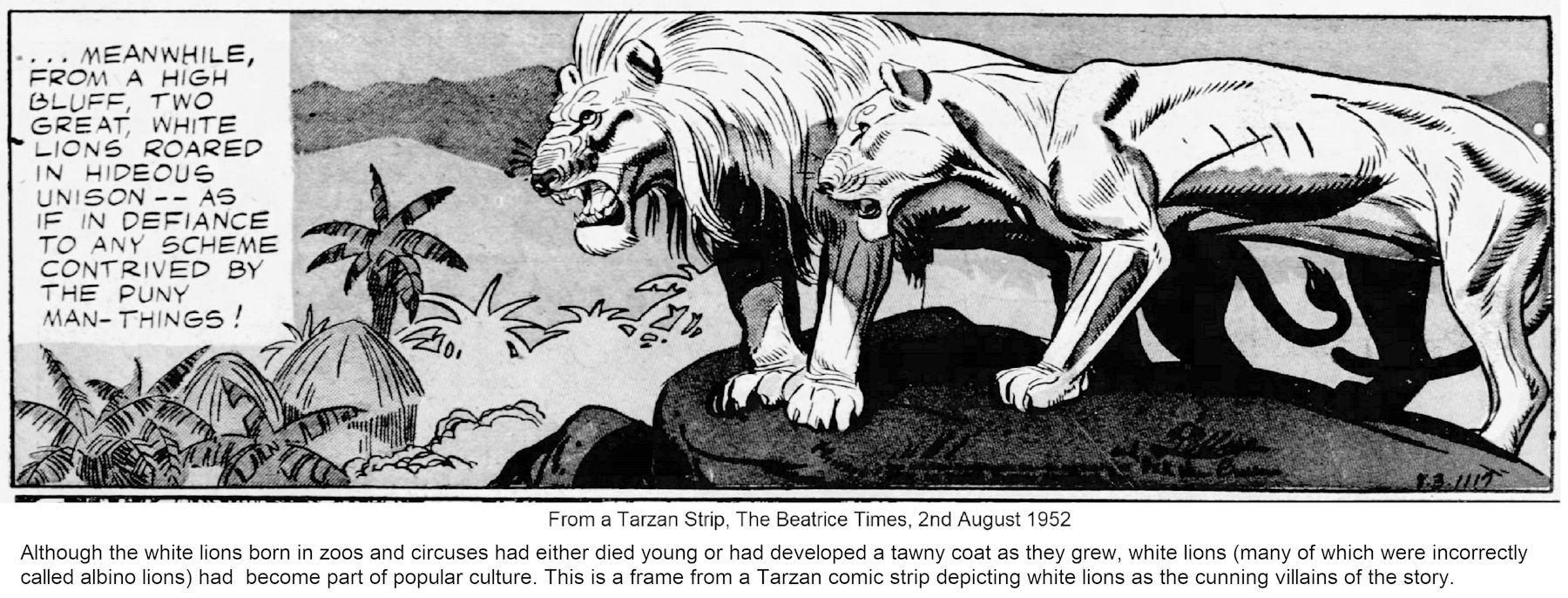
The Timbavati White Lions
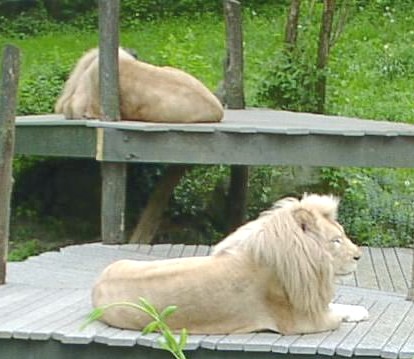
White Lions at Cincinnati Zoo (Photo by Phil Molyneux) |
The first authenticated sightings were in 1928. An albino lion cub which was featured in the Milwaukee Journal, May 25, 1935, which was born at the Gay lion farm in El Monte, California ("Albino Lion Born in California"). The first African White Lion sighting by a European was in the Peru area of Timbavati in the early 1940s by Joyce Mostert, whose family owned large tracks of land in the area. During March 1959, twelve lions with 2 white cubs were seen near Tshokwane in the Kruger Park; though unfortunately they were never seen again. David Alderton's "Wild Cats Of The World" claimed there were albino lion cubs in Kruger in 1960, but they were more likely to have been white lions. An albino lion cub was born in the Adelaide Zoo in Australia in 1961, according to an article from "The Age," dated July 5, 1961, but an article in "The Age," dated July 7, 1961 states "Albino Lion Cub Dies." In 1974, a light grey lion cub was born at Birmingham Zoo, Alabama, but was darker than the Timbavati white lions reported a year later.
No truly white lions were captured until 1975 when a litter containing 2 white cubs was found at Timbavati Game Reserve, adjacent to Kruger National Park. The white cubs were discovered by researcher Chris McBride. Their story is documented in the book "The White Lions of Timbavati". The 2 cubs were a male and a female that they named Temba (Zulu for "hope") and Tombi ("girl"). Their tawny brother was called Vela ('surprise') and sired a litter before being sold by Pretoria. Mcbride realised that the white cubs were disadvantaged in the wild - they were highly visible to both prey and to predators. Temba, being a male, would eventually be ejected from the pride and become nomadic until he managed to take over another pride. As a nomad, the highly visible Temba would have little chance of catching prey and would most likely starve. Tombi was safer, since lionesses remain with the pride, but would be at risk if she was ejected for any reason. More than once, the white cubs were found in an emaciated condition and the researchers found it necessary to provide kills for them..
In 1976 a white female cub was born among a large litter north-west of Tshokwane; at about 2 years old her colour darkened considerably. In 1977, an aerial census of the Central District observed a white male lion approximate 2 years old and yellow-white rather than pure white. By the age of 4, this lion (which had formed an alliance with 2 other adult males) was also darker, but its tail tip remained buff rather than becoming black. In August 1976, a white female cub was sighted in another subgroup of the pride and belonging to a different lioness. She was named Phuma (meaning "to be out of the ordinary"). She was part of a large litter that displayed a gradation of colour ranging from pure white, through pale blond to normal tawny. At the age of about 2 years, this female left the Timbavati reserve and was unfortunately killed. Her skin was later found for sale in a shop in the town of Sabi. This prompted concerns that Temba and Tombi would meet the same fate. As a result, McBride decided to capture Temba, Tombi and Vela (although tawny, Vela carried the gene for white). The cubs were taken to the National Zoo in Pretoria, South Africa where Temba produced several cubs before his death in 1996. In 1981, The white female produced a pure white cub which unfortunately died shortly after birth. Vela was sold and went to an unknown destination. It is not known whether Vela left any descendants, though the white lions in the Ouwehands Dierenpark (Netherlands) and a private South African Zoo appear to be from the Temba a Vela lines. Since the removal of Temba, Tombi and Vela, only a few white or pale cubs were born from time to time. One female lived for several years and was often seen hunting with her pride; she was killed in a territorial fight in 1993 and no white lions have survived since then.
Pretoria Line - White Lions of Timbavati Genealogy (large image, opens in new window)
In August 1980, "The White Lions," a movie was filmed about the discovery of the white lions. It starred Michael York and Glynnis O'Connor. According to interviews with O'Connor "For the film they got a pair of cubs from a safari park and bleached the. But that's supposed to be a secret." (Los Angeles Times, 12th August 1980)
Many people believe the cubs should have been left to take their chances in the wild. The genes to produce white in lions are now believed lost in the general population. White lions were never seen anywhere other than Timbavati Game Reserve and the white gene pool was almost definitely limited to this area. Lions in Timbavati have been killed by poachers. Several lions survived from the original white lions of Timbavati and are descended from Temba. A heterozygous tawny lion at Pretoria carries the gene for white and could pass this on to his offspring. Two heterozygous tawny males were kept at Cincinnati Zoo and are now at a private reserve in Africa. A white female and a heterozygous tawny male are at the Zoological Animal Reproduction Center in Indiana, USA. A second female from the original strain was unfortunately she was killed by the other female while on loan to a zoo.
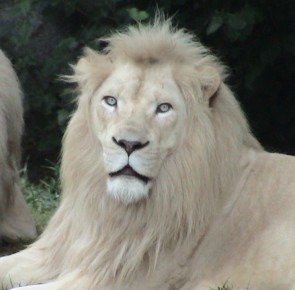
Legend at Toledo Zoo |
There is reportedly a third white lion bloodline that comes from a white male captured in the Timbavati area in the late 1980's and kept by a private reserve, but it is likely to be part of the original Timbavati bloodline. There is an unrelated strain of white lions at the Johannesburg Rhino and Lion Park, which was founded by a white cub discovered in the wild in the park. Thandile was spotted in July 1999 by a visitor to the Rhino and Lion Nature Reserve (a privately owned, non-subsidized game reserve) north of Krugersdorp. She had been abandoned by her mother and the visitor alerted two game wardens who retrieved the cub. Thandile was hand-reared. Ironically, the colour that would have made the cub vulnerable to predators in the wild had made her more visible to a person able to save her. Thandile has blue eyes, but is not albino. In 1998, a half-eaten white cub was found in the Rhino and Lion Reserve. (This reserve is not involved in canned hunts.)
Due to selective removal of white lions from the Timbavati region, this colour morph was in danger of extinction, but between 2006 and 2015 there were 15 known births of white lions in the Timbavati-Umbabat-Klaserie Private Nature Reserves, and 2 births of white cubs in central Kruger National Park. In May 2006, more than 10 years after any previous sightings of white lions, two white cubs were born alongside tawny cubs in the Umbabat Private Nature Reserve adjacent to Timbavati. In October 2006, two white cubs were born at Tabby's Crossing in the Timbavati Reserve. None of these cubs (white or tawny) survived. Their father was probably trophy hunted and the incoming male(s) would have killed any cubs in order to bring their mothers into oestrus.
Further white lions have been born in the Kruger National Park as the pride that produced the Timbavati white lions also spent much time there. In 2014, white cubs were born in the Kruger National Park (Nwanetsi-Singita Lebombo Concession) where there is no lion trophy hunting. There was supposedly a true albino lion living in Kruger at one time.
By 2013, there were three prides of white lions living naturally on land owned by the Global White Lions Protection Trust. Two of these groups have been integrated with wild tawny lions so that the white genes will occur at a natural level.
At present, all of the white lions in captivity come from the Kruger park subspecies and have not been bred with any other lion subspecies (unlike the comparable situation in white tigers). An exception is the white lion at Toronto zoo which was bred to a generic male. Unlike normal lion cubs which are born spotted, white lions are born almost pure white. Over the months, their colour gradually darkens to cream or ivory colour.
White Lion Trust Family Tree (large image, opens in new window)
Kruger and Umfolozi White Lions
There is more than one genetic strain of white lion. In 1977, Johannesburg Zoo caught a heterozygous male apparently from a different pride to that studied by Chris McBride. This wild tawny male came from litter that contained a white lion. Johannesburg Zoo claims to be the first in the world to have bred white lions in captivity. Timba, a brown lion from the Timbavati game reserve, was shot and was taken to the zoo for medical treatment. He was believed to have the rare white gene and was bred to a captive female and later mated to one of his own daughters.
In The Monitor, 31st March 1980 it was reported "First White Lion Cub Born in African Zoo. JOHANNESBURG. South Africa - A white lion cub has been born in captivity for the first time. Zoo officials said Tuesday, as the baby lioness made her first appearance with her brown brother . . . The cubs and their brown lion mother Timbi were sired by Timba. a white lion wounded by poachers in the Timbavati game reserve and brought to the zoo four years ago. . . The cubs weighed just over 2 pounds each when they were born Feb. 12 and have been named Danie and Bella the mayor of Johannesburg and his wife. . . Naturalists are unsure whether the comparatively rare white lion. Is a species in its own right or a mutation from the ordinary brown lion. The cubs' birth will allow full studies of their genetic makeup to be made. Another white lion cub was stillborn earlier this month to Suzy-Wong. a lioness also sired by Timba."
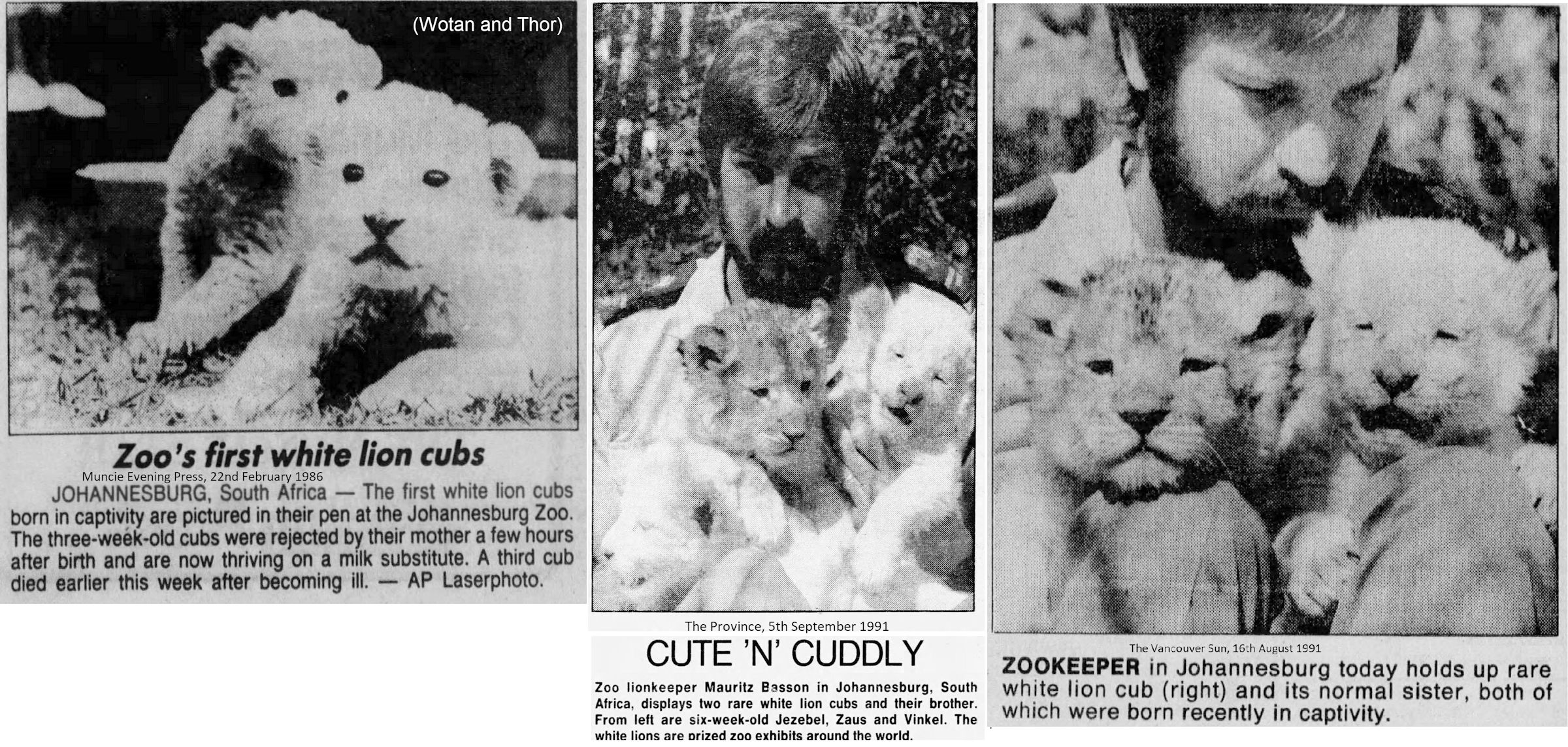
Timbi's white daughter Bella was born in 1982 (along with tawny littermate Danie) and she went on to produce many other white lion cubs. The lion that founded the Pretoria Zoo bloodline was known to have a white sibling in the wild and was therefore a carrier of the white gene. When mated with his own daughters, white offspring were produced. This bloodline is represented at zoos in Philadelphia, Toronto, China, Germany and Japan. In 1979, three different litters containing white lions were recorded in the huge Kruger National Park. In March 1979 a female lion with 3 white cubs was observed neat Tshokwane. In 1979, three litters containing white lions were recorded in Kruger National Park. In March 1979, a female lion with three white cubs was observed near Tshokwane. In September 1979, three white cubs (from two different lionesses) were seen. Another litter of white female cubs was captured from Kruger National Park and treated for sarcoptic mange. A white lion was observed in the Hluhluwe-Umfolozi Game Reserve in Zululand.
Johannesburg Line of White Lions (large image, opens in new window)
In 2010, two white lion cubs were reported in Ingwelala, adjacent to the Kruger National Park. They were born to a tawny lioness, demonstrating the gene still survives in the wild. Unfortunately both cubs disappeared.
In 2022, the Birmingham Pride in Kruger contained a young male and young female white lion. The female has been observed mating, so potentially there could be more whites on the way. There is also a young blue-eyed female with the Birmingham Pride. There is a possibly rufistic male associated with the Birmingham Pride in Kruger, who exhibits colouring similar to Ginger in South Luangwa. A white cub was observed in in the Shishangaan pride in Kruger in October 2022, with two tawny siblings.
The Sanbona White Lions
Conservationist Dr Gaston Savoi, Co-Chairman of Mantis Collection, aims to return the white lion to the wild (although they are really a mutant strain perpetuated in captivity by humans, just like white tigers). In 2003, white lion "Jabulani" and white lioness "Queen" were purchased and released into Sanbona Wildlife Reserve, South Africa. In May 2004, this pair produced 3 cubs (2 males, 1 female). In June 2004, a white lioness and her 3 five month old cubs joined them at Sanbona. The Global White Lion Protection Trust saved these animals from a life in captivity. These lions have made their own kills in addtion to receiving carcasses of zebra and kudu.
WHITE CUBS THAT TURN TAWNY
In addition to the white bloodlines, four white lion cubs were born at the Papanack Park Zoo outside Ottawa, but did not remain white. A white cub was born at an African Lion Safari in Florida years ago and also did not remain white. This is a condition called fever coat and usually due to the mother being unwell during pregnancy; the high temperature in the womb prevents pigment developing in the foetuses and the cubs are born very pale. They later develop the normal tawny colour. This is more often noticed in domestic cats and has also occurred in tigers.
According to The Los Angeles Times, 10th May 1977 (Three Rare White Lion Cubs May Not Survive) in a report on the discovery of three white lion cubs at Timbavati Game reserve: According to zoologists, pure white lions have never before been recorded. They are different from albino cubs, which invariably turn yellow after a few months. Albinism is a genetic mutation (both normal-coloured parents must carry the recessive albino gene in order to have albino cubs), but most of the so-called albino lion cubs were not genetic albinos but were white due to fever coat.
See White Lions - Historical Accounts of White Cubs for news reports of "albino" or "white" lion cubs born in captivity as far back as 1851. Those that survived to adulthood changed colour and only one - born in Robinson's Circus in 1890 - was described as a pink-eyed albino (it was killed by the mother when a keeper tried to touch it.)
WHITE LION GENETICS
White lions are not albino (unpigmented) but are leucistic - leucism describes an effect rather than a particular gene. They have pigmentation which is visible in the eyes, paw pads and lips. Their eyes are usually the normal hazel or golden colour although some have blue, blue-green or greyish-green eyes. At birth, the cubs are snowy white and may be described as resembling polar bear cubs. The birth colour gradually darkens to a pale cream colour known as blond (another name for white lions is blond lions). The mane and tail tuft remain a paler shade.
In the Long Island ocelot Club newsletter 23/2 April 1979, Pat Warren wrote "The Color Genetics of Hybrids" based on her F1 Geoffroy's Cat hybrids and F1 Leopard Cat hybrid. Warren considered the cream coloured "white lions" of Timbavati might be the recessive cream dilute of a red colour familiar to domestic cat breeders. In 2008, it was suggested that some very pale captive lions had a gene analogous to "champagne" in horses.
Although the mutation occurred naturally in the wild and has cropped up several times due to hidden recessive genes, white lions do not have a place in the wild. They lack the tawny camouflage needed for survival - this makes them visible to poachers and to the prey, reducing their effectiveness as predators. It is possible that the former range of lions may have included terrain where a blond colour was advantageous. Modern strains of white lions should be considered "man-made" much as a Persian cat is a man-made cat breed. There has been a recent trend in breeding pure white lions for zoo exhibits and animal acts. To ensure genetic diversity, they are crossed with tawny lions from the same region.
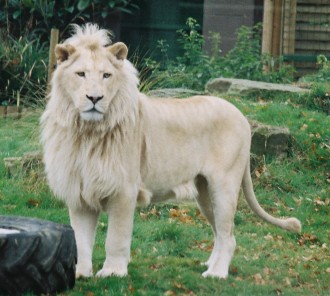
Thabo at Paradise Wildlife Park |
Skin and fur get their colour because the tyrosinase protein helps skin cells manufacture melanin. A genetic defect in tyrosinase leads to albinism because melanin cannot be made - either cannot be made at all, or cannot be made properly. This is "c-locus albinism" and it also affects the visual pathways, sometimes resulting in crossed eyes because the nerves from the eyes connect up in an abnormal way. In domestic cats, there are several albino mutations: Burmese sepia (changes black to brown, orange to yellow), Siamese colourpoint (colour is restricted to head/legs/tail), blue-eyed albino and pink-eyed albino. There is also the "Inhibitor" (Chinchilla) gene that prevents deposition of pigment on the hair shaft, but allows pigment at the hair tips - this is the mutation found in white Bengal tigers.
The normal colour of lions varies from sandy-golden through to tawny-brown with the male's mane being dark brown or black in some subspecies. Faded spots and rosettes may be visible under some lighting conditions. According to Roy Robinson, noted feline geneticist, white lions have either the chinchilla or acromelanism mutation. Some older literature mistakenly referred to chinchilla as a form of albino. The appearance of blond and white lions (colloquially called leucism) means that colour variations in lions are probably more common than originally thought. The high mortality rate in lion cubs means that those colour variations haven't been observed in the past. White lions have survived due to human intervention.
Though not as common as white tigers, white lions are now being found in more and more zoos and may well be the current "must have" big cat. Their value as attractions may well send them down the same path as the white Bengal tiger: mass production, inbreeding and indiscriminate crossing with other subspecies e.g. to produce larger, showier manes for circus acts. Already they have been bred in bulk with no regard for health and used in canned hunts. If crossed with stripeless white tigresses, white or blond ligers would result - something almost certain to happen one day because the huge size of ligers makes them attractive exhibits.
For those interested in human genetics, albinism and leucism are found in humans; in one striking case of human leucism, a young girl of African origin presented with milk white skin, normally pigmented [brown] eyes and golden hair [personal observation, November 2003]
Textual content is licensed under the GFDL.
For more information on the genetics of colour and pattern:
Robinson's Genetics for Cat Breeders & Veterinarians 4th Ed (the current version)
Genetics for Cat Breeders, 3rd Ed by Roy Robinson (earlier version showing some of the historical misunderstandings)
Cat Genetics by A C Jude (1950s cat genetics text; demonstrates the early confusion that chinchilla was a form of albinism)
For more information on genetics, inheritance and gene pools see:
The Pros and Cons of Inbreeding
The Pros and Cons of Cloning
|
BACK TO HYBRID & MUTANT BIG CATS INDEX |